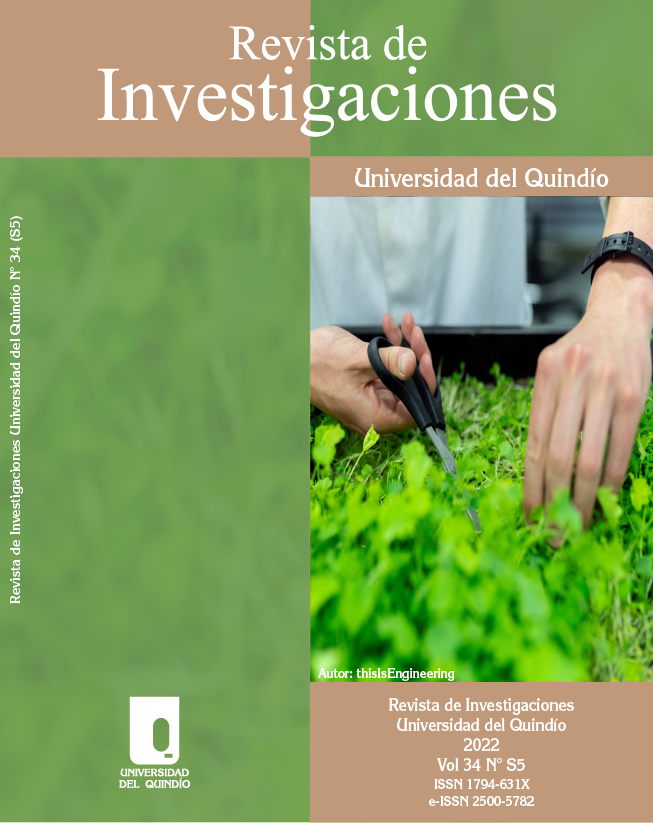Una revisión de las espumas poliméricas micro y nanoporosas: propiedades, técnicas de preparación, agentes espumantes y áreas de uso
DOI:
https://doi.org/10.33975/riuq.vol34nS5.1104Palabras clave:
Espuma polimérica, Agente espumante, Tipos de espuma polimérica, NanopartículaResumen
El objetivo de este estudio es proporcionar información general sobre todos los diferentes materiales de espuma polimérica con diversas morfologías, tamaños de poro y propiedades. Por lo tanto, en primer lugar, se explican los principios y técnicas de formación y las propiedades de las espumas poliméricas, y luego se proporciona información sobre los agentes espumantes físicos y químicos utilizados en la preparación de espumas poliméricas. Luego, se presenta una descripción general de los artículos sobre materiales de espuma polimérica.
Descargas
Citas
Adam N.,“A study of direct gas injection foam extrusion of polyolefins for a wire coating application”, Degree of Master of Science, University of Massachusetts Lowell, USA, (2006).
Saçaklı, M.,“ Polymeric foams”, Polymer Technology, 3th edition, Gazi kitabevi, Ankara, 350- 366 (2014). (in Turkish).
Srivastava, V., Srivastava, R., “On the polymeric foams: modeling and properties”, Journal Material Science, 49, 2681-2692, (2014). https://www.google.com/polimer Foams. Accessed on October 09, 2022. (in Turkish).
Koçyiğit, N., “ Improving the nonflammability properties of expandable polystyrene materials with nanoparticle reinforcement”,PhD,Gazi University Institute of Science and Technology, Ankara, 6-7, (2022).
Yetgin, S.H., Ünal, H., “Polymer-based foam materials”, D.P.Ü. Institute of Science and Technology Polymer Based Foam Materials, 17, 2008.
Kılıç, F., “Chemical recovery of waste blown polystyrene”, Istanbul University Institute of Science and Technology, Chemical Engineering, İstanbul,15, (2007)
Şahin, T., “Optimization of insulation material production parameters from inflatable polystyrene beads”, M.Sc., Istanbul University Institute of Science and Technology, İstanbul, 4-6, (2012).
Maio, E.D.,Mensiteri, G.,Iannace, S.,Nicolais, L.,Li, W.,Flumerfelt, R.W.,“Structure optimization of polycaprolactone foams by using mixtures of CO2 and N2 as blowing agents” ,Polymer Engineering and Science, 45(3), 432-440, 2005.
Lee, L.J.,Zeng, C.C.,Cao, X.,Han, X.,Shen, G.,“Polymer nanocomposite foams”,, ), 2344-2363 (2005).
Wang, L.,Zhou, H.,Wang, X.,Jianguo Mi, J.,“Evaluation of Nanoparticle Effect on Bubble Nucleation in Polymer Foaming”,The Journal of Physical Chemistry C, 120(47), 26841-26851, 2016.
Liu, S.,Zoetebier, B.,Hulsman, L.,Zhang, Y., Duvigneau, J.,Vancso, G.J.,Nanocellular polymer foams nucleated by core-shell nanoparticles”, Polymer,104, 22-30, (2016).
Liu, S.,Beer, S.D.,Batenburg, K.M.,Gojzewski, H., Duvigneau, J., Vancso, G. J., Designer core-shell nanoparticles as polymer foam cell nucleating agents: The impact of molecularly engineered interfaces”, ACS Applied Materials & Interfaces, 13(14), 17034-17045, (2021).
Colton, J.S.,Suh, N.P.,“The nucleation of microcellular thermoplastic foam with additives Part I. Theoretical considerations”, Polymer Engineering Science, 27(7), 485 (1987).
Colton, J.S.,Suh, N.P.,“The nucleation of microcellular thermoplastic foam with additives Part II. Experimental results and discussion”,Polymer Engineering Science, 27(7), 493 (1987).
Colton, J.S.,Suh, N.P.,“Nucleation of microcellular foam: Theory and practice”,Polymer Engineering Science, 27(7), 500 (1987).
Liu, S.,Eijkelenkamp, R.,Duvigneau, J.,Vancso, G.J.,“Silica-assisted nucleation of polymer foam cells with nanoscopic dimensions: Impact of particle size, line tension, and surface functionality”, ACS Applied Materials Interfaces, 9, 37929-37940, (2017).
Goren, K.,Chen, L.,Schadler, L.S.,Ozisik, R.,“Influence of nanoparticle surface chemistry and size on supercritical carbon dioxide processed nanocomposite foam morphology”,The Journal of Supercritical Fluids, 51(3), 420-427, (2010).
Emrani, A.S.,Nasr-El-Din, H.A.,“An experimental study of nanoparticle-polymer-stabilized CO2 foam”,Colloids and Surfaces A: Physicochemical and Engineering Aspects, 524,17-27, (2017).
Zeng, C.,Han, X.,Lee, L.J.,Koelling, K.W.,Tomasko, D.L.,“Polymer–clay nano composite foams prepared using carbondioxide”,Advanced Materials,15(20), 1743-1747 (2003).
Cao, X., Lee, L.J.,Widya , T.,Macosko, C.,“Polyurethane/clay nano composites foams: processing, structure and properties”,Polymer, 4(3), 775-783 (2005).
Shen, J., Zeng, C., , L.J.,“Synthesis of polystyrene–carbon nanofibers nanocomposite foams”, , ), 5218-5224 (2005).
Alteepping J.,Nebe, J. P.,“Production of low density polypropylene foam”,USA Patent, 4(940), 736, (1990).
Ünal, H.,Yetgin, S.H.,“Polipropilen köpük malzemenin mekanik özelliklerine ve hücre morfolojisine proses şartlarının etkisinin incelenmesi”,IATS’11,6th International Advanced Technologies Symposium, Elazığ,17, 117-128 (2011).
Haurat M.,Dumon, M.,“Amorphous polymers’ foaming and blends with organic foaming-aid structured additives in supercritical CO2, a way to fabricate porous polymers from macro to nano porosities in batch or continuous processes”, Molecules, 25(22), 5320 (2020).
Lee, E.K.,“Novel manufacturing processes for polymer bead foams”,The Degree of Doctor of Philosophy, Department of Materials Science and Engineering University of Toronto, Canada, 33-42 (2010).
Camargo, P.H.C.,Satyanarayana, K.G.,Wypych, F.,“Nanocomposites: Synthesis, Structure, Properties and New Application Opportunities”,Materials Research, 12(1), 1-39, (2009).
Hamadneh, N.,“Science and applications of Tailored Nanostructures Polymer nanocomposites-synthesis techniques, classification”,Science and applications of Tailored Nanostructures, 4th Chapter,50-53.
Aram, E.,-Ataei, S., M.,“A review on the micro- and nanoporous polymeric foams: Preparation and properties”, International Journal of Polymeric Materials and Polymeric Biomaterials, 65(7), 358-375 (2016).
Coste G.,Negrell, C.,Caillol, S.,“From gas release to foam synthesis, the second breath of blowing agents”,European Polymer Journal, 140, 110029, (2020).
Ruiz, J.A.R.,Vincent, M., Agassant,J.-F.,Sadik, T.,Pillon, C.,Carrot, C.,“Polymer foaming with chemical blowing agents: Experiment and modeling”,Polymer Engineering and Science, 55(9), 2018-2029, (2015).
Jin, F.-L.,Zhao, M.,Mira Park, M.,Park, S.-J.,“Recent trends of foaming in polymer processing: A review”, Polymers, 11, 953, (2019).
Koçyiğit, N., “Expandable polystyrene foam blowing agents”,UBAK, 3rd International Congress of Applied Sciences, Diyarbakır, 76-78, (2019).
Sauceau, M., Nikitine, C., Rodier, E., Fages, J., “Effect of supercritical carbon dioxide on polystyrene extrusion”, Journal of Supercritical Fluids, 43(2), (2008).
Chul B. P., Lewis K. C., “A Study of Cell Nucleation in the Extrusion of Polypropylene Foams”,Polymer Engineering and Science, 37(1), 1-10 (1997).
Cisneros, C.T.,Nunez R.G.,Rodrigue, D.,“Effect of mold temperature on morphology and mechanical properties of injection molded HDPE structural foams”,Journal of Cellular Plastics, 44, 223-237 (2008).
Xin, Z. X.,Zhang, Z. X.,Pal, K.,Byeon, J. U.,Lee, S. H.,Kim, J. K.,“Study of microcellular injection-molded polypropylene/waste ground rubber tire powder blend”,Materials and Design, 31, 589-593 (2010).
Descargas
Publicado
Cómo citar
Número
Sección
Licencia
Derechos de autor 2022 Revista de Investigaciones Universidad del Quindío

Esta obra está bajo una licencia internacional Creative Commons Atribución-NoComercial-SinDerivadas 4.0.


